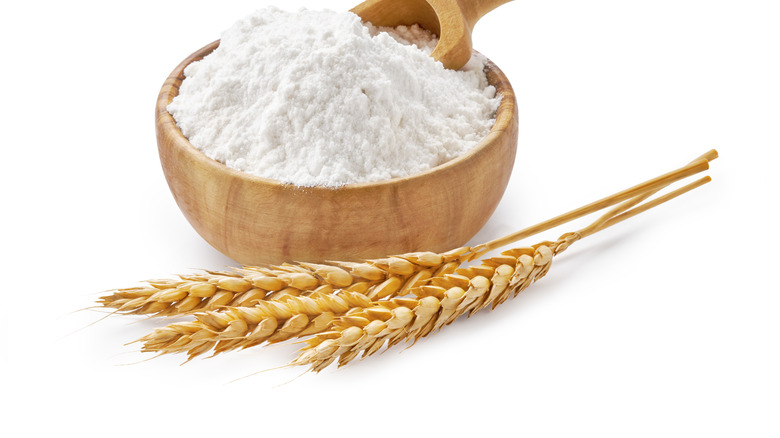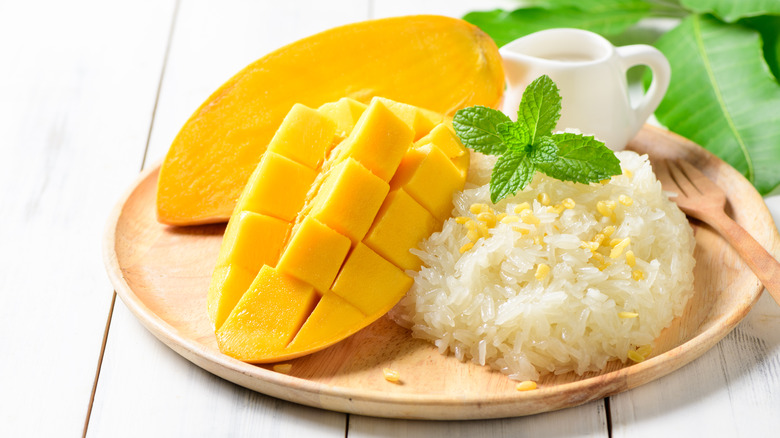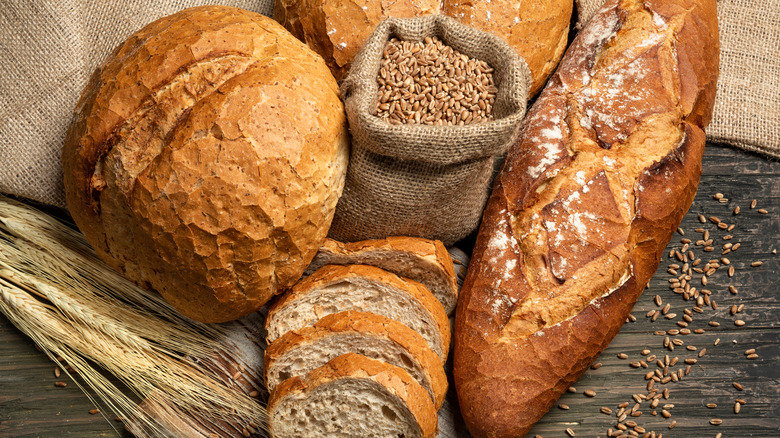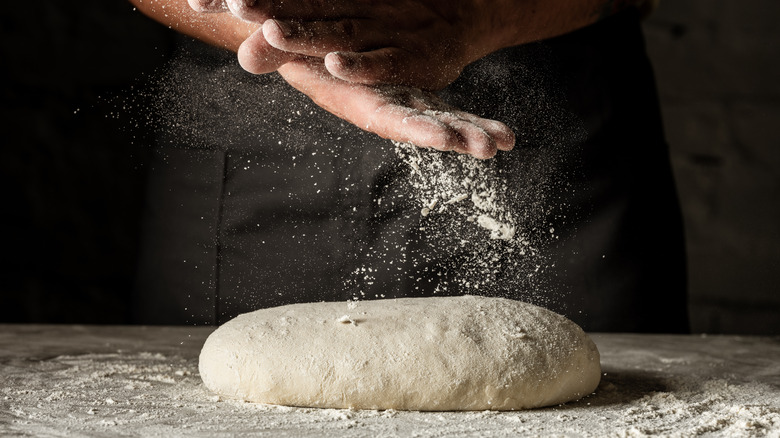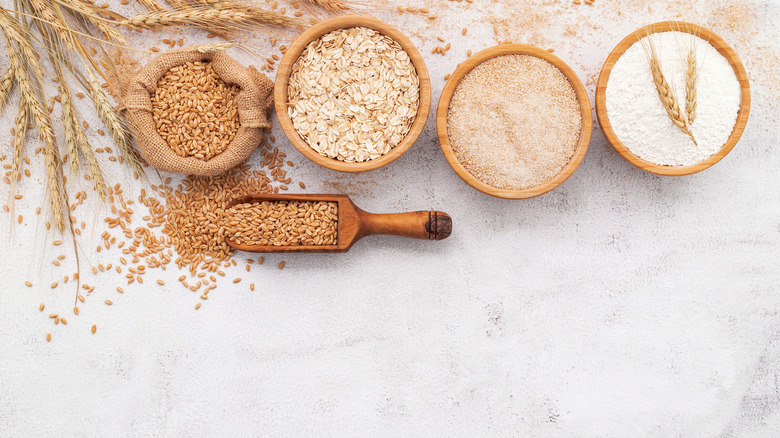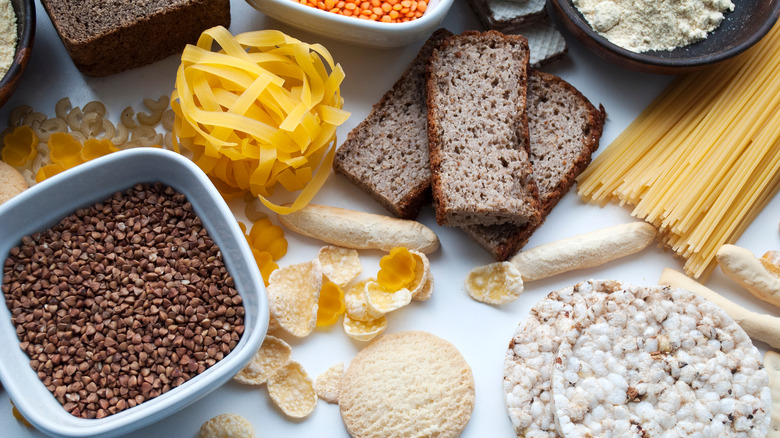What Exactly Is Gluten And Is It Bad For You?
In recent times, gluten has turned into something of a culinary boogeyman. It seems like every time you go to the grocery store, new gluten-free packaged goods arrive on the shelf. Some foods that never contained gluten in the first place have updated their labels to brag about their gluten-free status. Especially if you hang out with a health-conscious crowd, you probably know people who have eaten bread their whole lives but recently decided that gluten is their mortal enemy.
With all this hoopla, you'd think that gluten was a dangerous and harmful food additive. In reality, it's a natural component of many commonly-eaten grains that's harmless, even beneficial, to the health of the vast majority of people. Poor, misunderstood gluten is actually a wonder compound that's responsible for the incredible versatility of wheat dough. It's the magician behind the scenes that turns simple flour and water into everything from fluffy Wonder Bread to crunchy sourdough boules to bouncy ramen noodles. In this article, we will get to the bottom of gluten, exploring why it's so useful in cooking — and why some people shouldn't eat it.
What is gluten?
Gluten is a family of proteins found in many grains, including barley, rye, and most notably, wheat. From the plant's perspective, gluten is crucial because it helps feed baby seedlings while they germinate (via Live Science). Over history, humans have figured out many ingenious ways to nourish themselves with gluten as well.
The term gluten refers to a group of hundreds of different proteins, but only two of them are important for cooking: gliadin and glutenin, which are both abundant in wheat flour. Gliadin helps dough trap air bubbles as it cooks, making bread rise, while glutenin makes dough stretchy and elastic. Per Modernist Cuisine, the gluten in flour only activates once these proteins are exposed to water during the dough-making process. Mixing speeds up gluten development because it incorporates water into flour more quickly. With time, enzymes called proteases arrange the gluten proteins into a web-like structure made up of interconnected strands. This structure makes wheat dough sturdier and stretchier than gluten-free doughs.
What foods contain gluten?
Some gluten-containing foods are easy to spot. Per the Celiac Disease Foundation, anything made out of wheat flour, including bread, pasta, pancakes, biscuits, and tortillas, will have gluten in it. The same goes for products made from grains like barley and rye. That means it's in beer, as well as most crackers and baked goods. Companies make gluten-free versions of many of these products, but if the label doesn't say it's gluten-free, it probably isn't. The only exception to this rule is hard liquor, as the distillation process removes gluten from grains.
Beyond the obvious wheat-based products, many foods may sneakily have gluten added to them. Soy sauce uses wheat in its recipe, so it has a small amount of gluten. Frozen french fries are often coated in a batter which can sometimes include wheat flour. Breakfast cereal and granola frequently contain trace amounts of gluten even if they're not made with wheat. If you're trying to avoid gluten, any processed food or restaurant dish is a potential threat that must be checked before it can be safely consumed. Gluten can even find its way into non-food products like Play-Doh, vitamins, cosmetics, and medication.
Do oats have gluten?
If you know the grains that contain gluten, you might find it confusing that some oats are marketed as gluten-free, given that oats naturally don't have gluten in them. Before you write off that label as a silly trend-chasing advertising ploy, you should know that most oats in the U.S. market are contaminated with enough gluten to sicken someone with celiac disease. Popular Science explains that oats and wheat are often grown close to each other, or even in the same fields. Most oats are processed on machinery that's also used for wheat. The level of contamination is small, amounting to a few stray wheat grains, but that's more than enough to trigger celiac symptoms.
In order to be labeled gluten-free, products in the U.S. must contain less than 20 parts per million of the protein. Popular Science cited two studies that indicated that between 71% and 88% of conventional oats failed to meet that standard. To ensure that your oats are actually gluten-free, you need to check the label. The safest bet is to look for oats produced under the purity protocol, which mandates that they grow separately from wheat and aren't processed on shared equipment (via Gluten Free Watchdog).
Does glutinous rice contain gluten?
Sometimes gluten shows up in unexpected places, and sometimes it isn't there when you think it would be. According to The Kitchn, that's the case for glutinous rice, commonly known as sticky rice. Confusingly, "glutinous" doesn't mean filled with gluten (that would be "glutenous"). Rather, glutinous is a little-used word that means gluey or gummy (via Merriam-Webster). While gluten is sticky, it's not the substance responsible for glutinous rice's distinctive texture. That honor goes to a type of starch called amylopectin that traps moisture and makes rice stick together. We have amylopectin to thank for the addictive mouthfeel of treats like mochi, sticky rice cakes, and Thai mango rice.
Glutinous rice is safe for celiacs and people with other forms of gluten intolerance. If you order it at a restaurant, however, you should ask about how it was prepared, as there's a chance it could become contaminated with gluten during the cooking process.
Gluten vs. seitan
Seitan is a concentrated form of gluten that's often used as a substitute for meat. Its springy, slightly stringy texture is very similar to animal flesh, and its mild flavor adapts well to a wide variety of seasonings. It's a good alternative to tempeh and tofu for people who can't eat soy products. At its most basic, seitan is just pure gluten, but most commercially-made seitan adds seasonings to liven it up.
Seitan is made by mixing water and flour together into a dough, then kneading it until the gluten is fully developed. The dough is then rinsed under running water, which removes almost all of the starch, leaving behind a hunk of protein. According to the book "History of Soy in China and Taiwan," Chinese people have been eating wheat gluten for thousands of years, especially devout Buddhists who practice religious vegetarianism. Modern, pre-seasoned commercial seitan was first developed in Japan in the 1960s.
Gluten vs. vital wheat gluten
Vital wheat gluten is a dried, powdered wheat protein that's often used as an additive in baking. Since gluten helps strengthen the structure of bread dough, adding a little extra in the form of vital wheat gluten can improve your results when you want a sturdy, chewy product. It can also make up for the gluten shortcomings of rye or whole wheat flour, both of which have less protein than white flour. The gluten will help doughs made from these grains become more cohesive, improve the rise, and give them a lighter interior texture.
Vital wheat gluten is basically seitan that's been dried and then ground into a powder, so it's a good shortcut for making your own seitan at home. Instead of laboriously kneading dough and spending precious time rinsing it in the sink, you can simply rehydrate vital wheat gluten with the seasonings of your choice to create a homemade meat substitute.
Where to buy gluten
You can buy products with gluten in them pretty much everywhere food is sold. As anyone with celiac disease with tell you, it's often much easier to buy gluten-containing products than it is to avoid them. Wheat and wheat-derived products are a ubiquitous part of the food landscape all across the globe, and no matter where you are, grocery stores will offer a vast selection of baked goods and packaged products chock-full of the stuff. If you're trying to buy seitan or vital wheat gluten, however, you might have to do a little bit of digging.
As more American consumers try to reduce the amount of meat they eat, the options for plant-based proteins in normal grocery stores have improved considerably. That said, seitan is still a specialty item in America, so there's no guarantee you'll find it at your local grocer (via Plant Prosperous). If they do carry it, it will likely be next to the tofu or in the freezer section next to other plant-based meats. Health food stores or Asian markets will be better bets if you have any in your area. If it's vital wheat gluten you're after, there's a strong chance you'll have to buy it online from a vendor like Bob's Red Mill.
What does gluten taste like?
Gluten doesn't have much of a flavor by itself. The Institute of Food Technologists describes the taste of plain gluten as chalky and starchy. The texture is more interesting, with a stringiness they compare to "weak bubble gum." In the form of seitan, gluten acts as a blank canvas for whatever marinade or spices that were used to season it. Mosaic Foods likens seitan to plain chicken breast or portobello mushroom caps, foods that don't bring much flavor to the party themselves but can play well with almost any other ingredient because of their mildness.
While gluten might not taste like anything to most of us, some people with celiac disease or gluten intolerance claim that they are hypersensitive to its flavor. This forum thread from Celiac.com is filled with gluten intolerant folks who say that they notice the taste of gluten when it has snuck into their food by accident. Multiple posters mention a bitter or metallic taste, and another describes the flavor as "pasty."
How is gluten used in cooking?
Mastering the art of working with wheat-based doughs is all about controlling gluten formation. Modernist Cuisine explains that the amount of gluten in a dough is a result of the type of flour you use, how much water you add, and how long you mix it for. More water and mixing creates more gluten, and high-protein bread flour has more gluten than cake flour does. You can also encourage gluten development by adding salt, or restrict it by adding fat. The appropriate technique depends on your desired end result. If you're making a chewy artisan loaf, you want as much gluten as possible. For pancakes, biscuits, and cakes, the goal is to try to minimize gluten development to produce a fluffy, soft product.
In its seitan guise, gluten can be cooked in most of the same ways you would prepare meat (via Mosaic Foods). It can be ground into a substitute for hamburger, stir-fried, tossed on the grill, deep-fried, or simmered. Just remember to go heavy on seasoning, as you need to compensate for its inherent blandness.
Nutritional information about gluten
Although they're made from wheat, concentrated gluten products are very low in carbohydrates. The nutritional information for Bob's Red Mill vital wheat gluten flour shows that one 30-gram serving has 23 grams of protein and only three grams of carbs. It also doesn't have very much fat, with only one gram per serving, or 1% of the recommended daily value for an average person. The nutrition profile of seitan can change depending on what the manufacturer uses to flavor it, but the brand that The Healthy tested had very similar nutritional facts to pure gluten, with a little less protein and a little more carbs because of some added sugar.
While gluten contains a similar amount of protein to meats like chicken breast, it only has a small amount of lysine, an essential amino acid (via Healthline). If you're following a plant-based diet, you need to supplement seitan with other sources of protein, like beans, in order to make sure your body gets enough lysine.
Is gluten bad for you?
For people who can digest it, gluten is perfectly harmless. It's present in many healthy whole grain foods, and it can make for a high-protein, low-fat meat substitute. In fact, staying away from gluten unnecessarily could be deleterious to your health. However, a large number of people can't eat gluten for a variety of health reasons. Harvard estimates that about 1 out of every 133 Americans has celiac disease, an autoimmune disorder in which the body reacts to gluten like a poison, causing an immune system inflammation response. If people with celiac eat wheat products, they can experience symptoms like weight loss, intestinal damage, and digestive issues. A wheat allergy is a related but different disorder in which the proteins in wheat, including but not limited to gluten, provoke an immune response.
If you don't test positive for celiac but experience discomfort and digestive symptoms from eating gluten, you may have gluten sensitivity, also known as gluten intolerance. According to Healthline, some research indicates that gluten increases the risk of a "leaky gut," which can lead to food sensitivity and autoimmune issues. However, the current studies are inconclusive, so the jury is still out on this issue.
How can you tell if you're gluten intolerant?
There is no test that can detect non-celiac gluten sensitivity, so diagnosis requires experimentation (via Cleveland Clinic). If you often experience symptoms like gastrointestinal pain, fatigue, nausea, or confusion after eating gluten, you may want to talk to your doctor about your issues. They will likely have you eat a normal gluten-containing diet for a few weeks so they can do lab tests to rule out celiac and wheat allergies. If you test negative, then you can cut gluten out of your diet to see if that reduces your symptoms. If you are gluten intolerant, you're in good company: Around 6% of people in the U.S. suffer from some kind of gluten sensitivity.
The only real treatment for gluten sensitivity is to avoid eating gluten. While this might seem like a cruel fate to those of you who can't live without pizza, bread, and pasta, the good news is that the growing awareness of gluten issues has made gluten-free substitutes much more widely available in recent years. These days, just because you can't have gluten doesn't mean you can't enjoy a nice piece of toast or a bowl of spaghetti carbonara.

